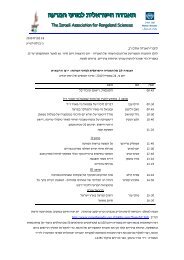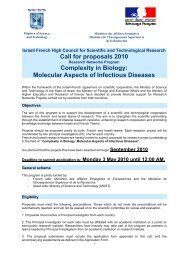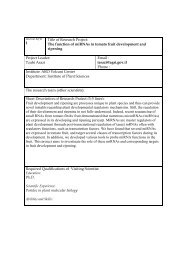Ghanim et al 1998 - Virology .pdf
Ghanim et al 1998 - Virology .pdf
Ghanim et al 1998 - Virology .pdf
You also want an ePaper? Increase the reach of your titles
YUMPU automatically turns print PDFs into web optimized ePapers that Google loves.
296 GHANIM ET AL.PCR. Plasmid pTYH19 that contains a cloned copy ofthe TYLCV genome was used as a positive control.Figure 1B shows that the 410-bp TYLCV DNA fragmentthat was amplified from plasmid pTYH19, frominfected tomato, and from viruliferous whiteflies was<strong>al</strong>so amplified from the progeny of the viruliferousfem<strong>al</strong>es (eggs, crawlers, and adults), but not fromthose of nonviruliferous insects. These results suggestthat TYLCV is transmitted to the progeny of viruliferouswhiteflies through the egg.FIG. 1. An<strong>al</strong>ysis of viruliferous whiteflies and their offspring by PCR.(A) Development stages of the whitefly Bemisia tabaci and their duration,under our experiment<strong>al</strong> conditions. The first instar is the crawlerstage; the fourth instar is the pup<strong>al</strong> stage. (B) Amplification of TYLCVDNA from groups of 50 eggs, 20 crawlers and 20 adults, from offspringof viruliferous whiteflies, and from the same number of progeny ofnonviruliferous insects; infected tomato plants and plasmid pTYH19 arepositive controls. The reaction products were submitted to agarose gelelectrophoresis and stained with <strong>et</strong>hidium bromide. Thick arrow, amplifiedTYLCV DNA; thin arrow, primers.progeny of viruliferous insects for at least two generations.RESULTSPCR an<strong>al</strong>ysis of progeny of viruliferous whitefliesWhiteflies develop from an egg, through fournymph<strong>al</strong> instars, into an adult. Figure 1A shows thedevelopment<strong>al</strong> time course under our experiment<strong>al</strong>conditions. The association of TYLCV DNA with developingeggs of viruliferous insects was investigated.Viruliferous whiteflies were caged on eggplants andon cotton plants (about 20 insects per plant) and ontwo TYLCV nonhosts (Cohen and Nitzany, 1966; Al-Musa, 1982). The adults were collected after 5 daysand the eggs were <strong>al</strong>lowed to develop. Samples fromeach development<strong>al</strong> stage (Fig. 1A) were collected atrandom. Tot<strong>al</strong> DNA was extracted from groups of 10viruliferous fem<strong>al</strong>es, 50 of their eggs, 20 crawlers, and20 adult progeny. In par<strong>al</strong>lel, DNA was extracted fromthe same number of nonviruliferous fem<strong>al</strong>es, theireggs, crawlers, and adult progeny and from an infectedtomato leafl<strong>et</strong>. All samples were subjected toThe offspring of a single viruliferous whitefly containTYLCV DNAThe question of wh<strong>et</strong>her TYLCV is present in <strong>al</strong>l progenyof a single viruliferous insect was addressed. Viruliferouswhiteflies were <strong>al</strong>lowed to lay eggs on eggplants(one insect per plant). After 5 days, the insects werecollected and eggs were <strong>al</strong>lowed to develop. In accordancewith the development<strong>al</strong> time sc<strong>al</strong>e of Fig. 1A,eggs, crawlers, pupae, and adults were collected in sucha fashion that <strong>al</strong>l the individu<strong>al</strong>s at a given development<strong>al</strong>stage were progeny of a single insect. DNA extractedfrom each individu<strong>al</strong> was subjected to PCR amplification.Figure 2 shows the 410-bp vir<strong>al</strong> DNA fragment amplifiedfrom 16 of the 23 eggs laid by a single viruliferouswhitefly. Twenty-five of the 30 crawlers issued from anotherviruliferous insect contained vir<strong>al</strong> DNA as did 7 ofthe 13 pupae and 15 of the 16 adults issued from a thirdand a fourth insect. Hence, TYLCV was transmitted tosome, but not to <strong>al</strong>l, progeny of viruliferous whiteflies.This an<strong>al</strong>ysis was extended to the progeny of nineviruliferous whiteflies. Viruliferous insects were <strong>al</strong>lowedto lay eggs on eggplants and on cotton plants (one insectper plant). Eggs, first and second instars, and adultswere collected in such a fashion that <strong>al</strong>l the individu<strong>al</strong>s ata given development<strong>al</strong> stage were progeny of three differentinsects. The progeny from a single insect werekept separated from those of the other insects. DNA fromeach individu<strong>al</strong> was subjected to PCR amplification, asdescribed in the legend to Fig. 2. The results summarizedin Table 1 show that TYLCV DNA was amplifiedfrom some, but not from <strong>al</strong>l progeny. This proportionvaried from insect to insect. TYLCV DNA was present in<strong>al</strong>l of the development<strong>al</strong> stages of the whitefly, from eggto adult. Adult progeny of three addition<strong>al</strong> viruliferousinsects were used to inoculate tomato test plants (seebelow).The second-generation progeny of a singleviruliferous whitefly contain TYLCV DNAThe passage of TYLCV through the egg from the first tothe second generation of viruliferous whiteflies progenywas investigated using the m<strong>et</strong>hods described above.Eggs laid by whiteflies that had acquired TYLCV frominfected tomato were <strong>al</strong>lowed to develop on cotton. The
















